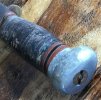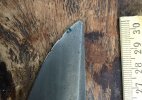oldmanwilly
Gold Member
- Joined
- Mar 7, 2014
- Messages
- 3,914
I meant to start a thread on this years ago but never followed through. A recent thread popped up asking for advice on an old Woodcraft and I decided to finally get to it.
I bought this old Woodcraft off the exchange in 2020. As you can see, it was well used and needed a little attention.



The leather handle had dried, compacted, and shrunk to the point that it had 1 or 2 solid pieces that would rattle together. The old washers had to go. I had to fashion a tool out of whatever this thing was (see below) in order to unscrew the pommel nut.
The original pommel nut was pretty badly damaged from previous attempts to (presumably) tighten it, and i basically had to destroy it in order to remove it (sorry, forgot to take pics at the time). I had to order another nut which had a diameter that was slightly too large. Being of limited means at the time I figured the only way I could evenly grind down the nut to fit was to fashion it to a customized drill bit (a bamboo chopstick) and spin it around a pice of sandpaper.
I was honestly shocked at how well it worked.
After removing the original washers I sanded down the tang to remove rust.
I bought this old Woodcraft off the exchange in 2020. As you can see, it was well used and needed a little attention.



The leather handle had dried, compacted, and shrunk to the point that it had 1 or 2 solid pieces that would rattle together. The old washers had to go. I had to fashion a tool out of whatever this thing was (see below) in order to unscrew the pommel nut.
The original pommel nut was pretty badly damaged from previous attempts to (presumably) tighten it, and i basically had to destroy it in order to remove it (sorry, forgot to take pics at the time). I had to order another nut which had a diameter that was slightly too large. Being of limited means at the time I figured the only way I could evenly grind down the nut to fit was to fashion it to a customized drill bit (a bamboo chopstick) and spin it around a pice of sandpaper.
I was honestly shocked at how well it worked.
After removing the original washers I sanded down the tang to remove rust.
Last edited:
